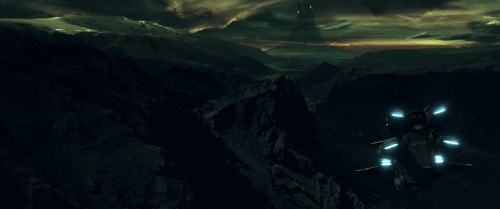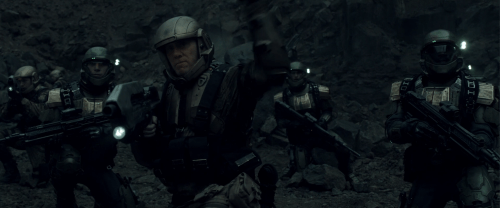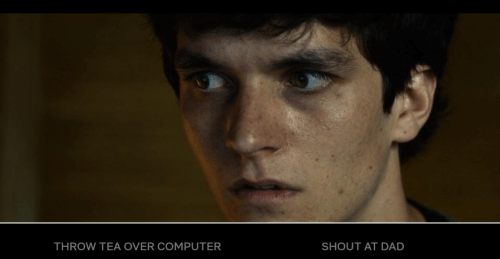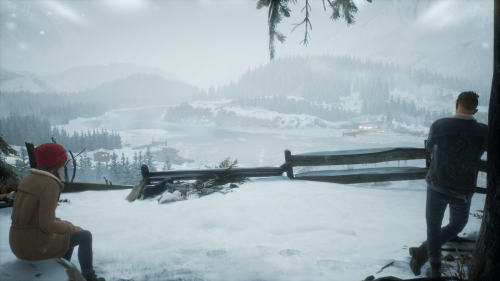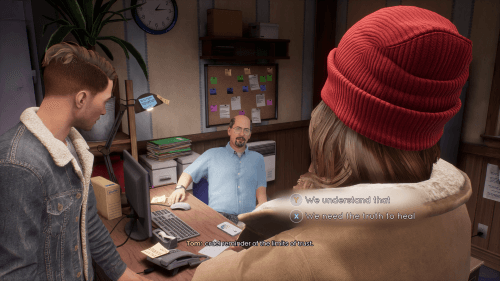I bet you thought this was going to be about Halo 5, didn’t you? Nope! We’re talking about the 2015 sequel to Spartan Assault, Halo: Spartan Strike! As with Spartan Assault, I didn’t know much about Spartan Strike before starting Halo Fest. Less so, in fact, given that it’s not even available for Xbox, sadly having never managed to make the leap from its original Windows and mobile versions. I honestly wasn’t even sure I was going to cover it because of that, but given how relatively small of a time commitment these games are coupled with the fact that both of them frequently go on sale on Steam for literally only a couple of bucks, I decided just to go for it.
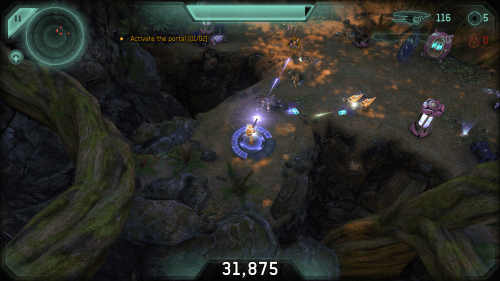
“Point holding in the steamy jungles of Gamma Halo.”
So, this is the first time I played a game on PC for this series. That wouldn’t be too notable, but given that it’s a twin stick shooter and I’m playing with keyboard and mouse instead of, you know, twin sticks, it seems pertinent. Actually, the keyboard and mouse control scheme is totally fine; you move, change weapons and grenades, and interact with your keyboard, and target and fire with your mouse. The limited directional movement is a little awkward, but other than the lack of an analog stick for speed (which occasionally resulted in what I assume is a bug where my character would get stuck walking despite there being no way to make him move that slowly on purpose) it’s simple and intuitive enough. In fact, I think I might have preferred it – I felt more like I was playing a hybrid RTS, something like Dawn of War 2, than a twin stick shooter. My only real complaint was an inability to shoot for a few seconds after throwing a grenade most of the time. I don’t know if this was intentional or a bug, but it was jarring in either case.
Graphically, relatively little has changed since the previous game. I think the it looks just a bit more detailed than Spartan Assault, but that may have to do with the more interesting locations these operations are set in than anything technical. Outside of the action, Spartan Strike keeps the combination of motion comic style cutscenes narrated by the Infinity’s AI Roland for each operation while each mission is presented by a map and a text blurb that describes the scenario. While the mission briefings are somehow a step back, losing much of their flavor, the artwork used in the cutscenes this time around is pretty damn awesome. See the Promethean Knight screenshot below for an example. The soundtrack receives an upgrade too. It’s almost like the developers realized they actually hired a competent composer in Tom Salta after the first game’s reviews (and his excellent work on Halo 2: Anniversary) and decided to turn him up in the mix a bit. I found myself really noticing and appreciating a lot of the music here, perhaps a first since 343 took over the franchise.
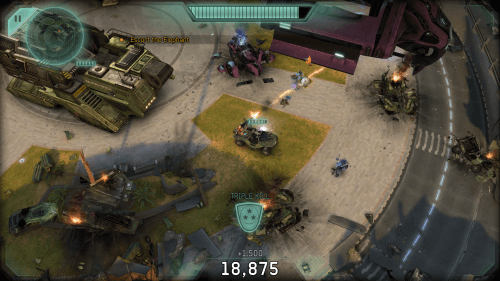
“Turrets and vehicle weapons no longer overheat. Great for me but not so much for these Covies.”
Gameplay wise, Spartan Strike doesn’t veer too far from what its predecessor did. Only, between the mysterious Lt. Kwon keeping us company Cortana style (seriously, who is this person?) to the missions feeling both a bit more varied and a bit closer to a mainline Halo game in complexity, I actually enjoyed Spartan Strike just a bit more. The only downside to this added complexity is that without any way to save your progress during these missions, despite their relatively short length, dying near the end of one can be frustrating. Of course, there are the conventional changes too: more weapons, armor abilities, and vehicles, not to mention more enemies with the introduction of Prometheans to the mix. Despite all of the complaining I did about them in Halo 4, I actually really like the way the Prometheans and their gear were implemented here. It’s not all good news though. While they addressed something I complained about last time by finally introducing the Warthog to the game, the poor thing feels uncharacteristically slow and handles like a cinder block. Come to think of it, the Ghost is rather slow too, so perhaps this is some kind of a limitation of the engine?
Like Spartan Assault before it, Spartan Strike’s story takes place sometime after the end of the Requiem Campaign from Halo 4’s Spartan Ops and is framed around Spartans aboard the UNSC Infinity using a TACSIM training simulator to experience historical battles, only this time they’re extra secretive ones. OooOOooh! The first episode takes place during the events of Halo 2 while the rest take place around the events of Halo 4. In a big departure from the first game, you’re playing an anonymous SPARTAN-IV rather than a named character. In fact, in the first operation your character is standing-in for the squad of ODST who actually originally took part in the mission. Well, it is a simulation, I guess?
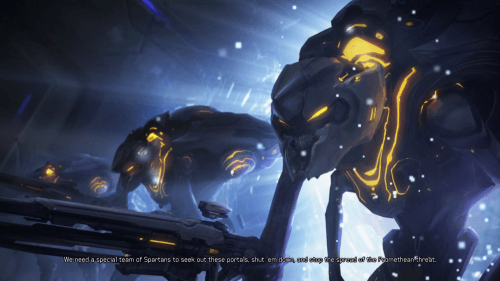
“Guess whose back!”
That being said, given that the story we’re actually focused on (the one being told via these simulations) takes place out of chronological order, I’ll go over the plot here. While I try to be somewhat vague with these summaries they do still contain spoilers, so skip the next paragraph if you want to avoid them.
The Story: In 2552 during the Battle of New Mombasa ODST squad Alpha-Five recovered a Covenant datapad containing details about a Forerunner artifact called the Conduit. Using the information on the datapad to track down the location of the Conduit, the team were able to eliminate a Sangheili Field Master and his retinue and acquire it. In the process of Alpha-Five transporting the artifact to safety, the Prophet of Regret’s carrier, the Solemn Penance, executed a low orbit slipspace jump over the city to devastating effect with the squad lost and the Conduit presumed destroyed. Five years later, researchers aboard Ivanoff Station detect what appears to be the Conduit’s signal on the surface of Gamma Halo. In response, the UNSC dispatches a SPARTAN-IV Headhunter to investigate. Discovering that Jul’Mdama’s Covenant faction is also on Installation 03, the Headhunter tracks the Conduit to a Forerunner facility called the Altar where the Covenant are using it to open slipspace portals to allow their Promethean allies to invade the ring. After a number of fierce skirmishes, the Headhunter is able to recover the Conduit and safely transport it off of the ring. Not long after, an urgent message is relayed from scientists at an ONI research facility in New Phoenix. The Covenant had activated the dormant slipspace portal the research facility was built around, with Covenant and Prometheans now pouring into the facility and surrounding city. Researchers believe that by using the Conduit they may be able to force the portal closed. Rushing back to Earth, the Headhunter is able to work with UNSC forces on the ground to secure access into the facility and ultimately halt the invasion, although the Conduit was once again lost in the effort.
I don’t have too much feedback to give about the story this time around. It’s fine. While there are aspects I don’t love (such as the Conduit’s all too convenient ability to teleport itself) I personally like that they’re trying to wedge the story into the existing events we know and love from the mainline campaigns, even if it does feel a little contrived at times. I mean, after enjoying Spartan Ops I’m definitely up for any inclusion of Jul’Mdama’s Covenant faction! I also believe this is the first time we’ve seen Spartan Headhunters featured in a game. Neat. As with Spartan Assault’s story, it’s really nothing too groundbreaking and while it might not do much to expand the Halo universe, it at least feels appropriately Halo-y and (as far as I know) doesn’t wreak havoc with the existing canon.
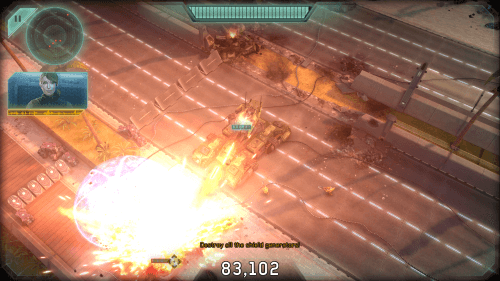
“Obligatory tank screenshot. This time, starring the voluptuous M850 Grizzly.”
Finally, I have to mention Operation E: Brother’s Keeper. This the last operation in the campaign but it can only be unlocked by beating every mission in the game with a gold star rating. As with Spartan Assault, there is no difficulty level in Spartan Strike, rather you’re awarded a different star rating at the end of each mission depending on your score. The easiest way to ensure a good score is by earning medals, and the main way to earn medals is by chaining kills. Considering this is a game all about mowing down masses of enemies, that’s not a huge ask. The first time through the campaign I got gold stars on probably 65% of the missions, and half of the ones I didn’t, I was extremely close to. Irritated by needing to replay missions to progress, I almost didn’t bother with the last operation at all, but not focusing so much on the “Assault Ops” challenges I found that most of them were a cakewalk to get gold on the second time around. Those that weren’t, I just spent my pool of otherwise unused credits on “score boosters” for. The operation itself though? The action was fine, but instead of a “real ending” or some kind of epilogue, the story was an odd, pointless retread of the rest of the campaign. Maybe if it were a hidden bonus rather than taunting you from the mission select menu I wouldn’t have cared quite so much.
So despite enjoying my time with the game slightly more than with Spartan Assault, I’d ultimately have to come to the exact same conclusion about it. That is, Spartan Strike is a decently executed, reasonably fun game that isn’t a bad way to spend 5 or 6 hours, especially if you particularly enjoy twin stick shooters and/or are a big Halo fan. However, at the end of the day it and its predecessor were more like experiments than an essential parts of the franchise. Now, at long last we move on to Halo 5…
